组织行为学精要第十版chapter16 organizational change
组织行为学第九章
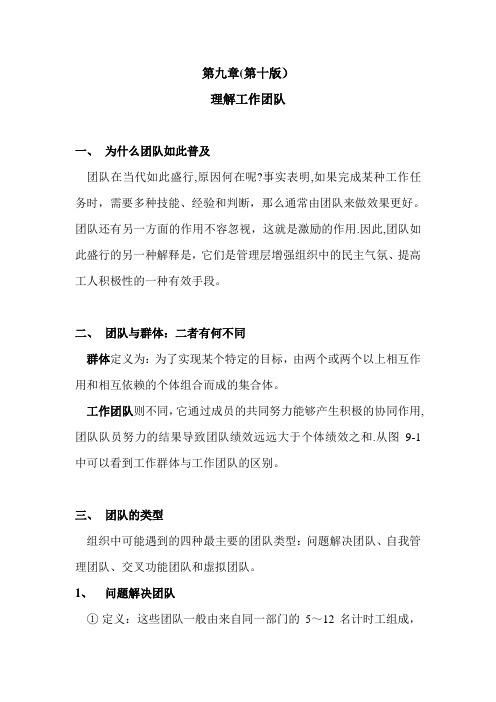
第九章(第十版)理解工作团队一、为什么团队如此普及团队在当代如此盛行,原因何在呢?事实表明,如果完成某种工作任务时,需要多种技能、经验和判断,那么通常由团队来做效果更好。
团队还有另一方面的作用不容忽视,这就是激励的作用.因此,团队如此盛行的另一种解释是,它们是管理层增强组织中的民主气氛、提高工人积极性的一种有效手段。
二、团队与群体:二者有何不同群体定义为:为了实现某个特定的目标,由两个或两个以上相互作用和相互依赖的个体组合而成的集合体。
工作团队则不同,它通过成员的共同努力能够产生积极的协同作用,团队队员努力的结果导致团队绩效远远大于个体绩效之和.从图9-1中可以看到工作群体与工作团队的区别。
三、团队的类型组织中可能遇到的四种最主要的团队类型:问题解决团队、自我管理团队、交叉功能团队和虚拟团队。
1、问题解决团队①定义:这些团队一般由来自同一部门的5~12名计时工组成,他们每周用几个小时的时间来会面,讨论如何促进产品质量、提高生产效率、改善工作环境等问题。
我们把这种团队称为问题解决团队。
②质量圈:他们定期会面,共同讨论质量问题、调查问题的起因、提出解决问题的建议,并采取纠正性的行动。
2、自我管理团队①定义:自我管理团队通常由10~15人组成,队员之间或者是工作业绩息息相关,或者是从事相互依赖性的工作。
他们承担了最多以前由主管承担的责任。
一般来说,他们的责任范围包括:计划和安排工作日程:给各成员分配工作任务;总体把握工作的步调;做出操作层面的决策;对出现问题采取措施以及与供货商和顾客打交道。
研究总体上表明,实施这种团队形式并不总能带来积极效果。
3、交叉功能团队①定义:这些团队由来自同一等级但不同工作领域的员工组成,他们为了完成一项任务而共同工作。
同样,由来及多个部门的成员组成的委员会是交叉功能团队的另一个例子。
②作用:交叉功能团队可以成为一种有效的方式,它使组织内部(甚至是组织之间)不同领域的员工交流信息,它激发人民采用新办法解决问题,并使人们共同合作完成复杂的项目。
《组织行为学》读书笔记完整版(上)
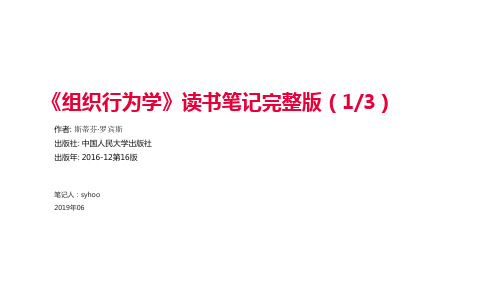
资源分配者
做出或批准组织中的重大决策
谈判者
在重要谈判中代表组织
8
人际角色
9
信息传递者角色
10
决策角色
11
1.2.3 管理者的技能
概念 技能
产生新想法并 加以处理,并 将关系抽象化 的思维能力
人际技能
成功与人打交道并沟通。 理解、沟通、激励、
支持他人,倾听、冲突管理
技术技能
特定领域的过程、惯例、方法、工具
以实现一个或一系列共同目标。
6
1.2.1 管理者的职能
管理者的五种职能:计划、组织、指挥、协调和控制。 ——亨利·法约尔
协调和指挥就是
领导职能:
激励下属;
指导别人的活动;
选择有效的最沟
通渠道。
指挥
解决成员间冲突。
协调
组织
管理者的五项职能
监控;比较;纠正;
7
控制
计划
决定要完成的任务; 谁来承担这些任务? 如何进行任务分类? 谁向谁报告工作在什么地方做 决策?
者的信任,其个人建议容易被高层采纳,工作满意度得到提升,同时个人 也容易获得成长和晋升的机会。
5 01
1.2 管理者做什么
• 管理者:
– 通过他人来完成工作。 – 通过做决策、分配资源、指导他
人的活动来实现工作目标。
• 组织:
– 人们有目的地组合起来的社会单 元
– 由两个或多个个体组成 – 在一个相对连续的基础上运作,
01
《组织行为学》第一篇 导论
第1章 什么是组织行为学
学习目标
• 人际关系在工作场所中的重要性 • 管理者的职能、角色和技能 • 组织行为学是什么? • 系统研究组织行为学的价值? • 对组织行为学有贡献的科学分支 • 组织行为学中没有绝对的真理,为什么? • 当前应用组织行为学面临的主要挑战和机遇 • 组织行为学模型的三种分析水平
组织行为学英文版(第13版)ch16

The Ethical Dimension of Culture Organizational cultures are not neutral in their ethical orientation, even when they are not openly pursuing ethical goals. Over time, the ethical work climate (EWC), or the shared concept of right and wrong behavior in that workplace, develops as part of the organizational climate. The ethical climate reflects the true values of the organization and shapes the ethical decision making of its members.
Copyright © 2015 Pearson Education, Inc.
16-8
LO 1
Describe the Common Characteristics of Organizational Culture
Strong versus Weak Cultures Strong culture – core values are intensely held and widely shared. Culture versus Formalization High formalization creates predictability, orderliness, and consistency. Formalization and culture are two different roads to the same destination.
组织行为学 目录(罗)

目录第一章绪论…………………………………………………第一节组织行为学的基本概念……………………………………第二节组织行为学的演进和发展…………………………………第三节组织行为学的研究方法……………………………………本章小结……………………………………………………………第二章个体心理现象与个体行为……………………………………第一节个体心理现象………………………………………………第二节个性倾向性与行为…………………………………………第三节个性心理特征与行为………………………………………本章小结……………………………………………………………第三章组织承诺和组织公民行为……………………………………第一节组织承诺与个体行为………………………………………第二节组织公民行为与个体行为…………………………………本章小结……………………………………………………………第四章人性理论……………………………………………………第一节人性理论概述……………………………………………第二节西方的人性理论……………………………………………第三节我国人性理论………………………………………………本章小结………………………………………………………………第五章群体心理、群体行为与群体绩效………………………………第一节群体概述……………………………………………………第二节非正式群体…………………………………………………第三节群体行为的一般规律……………………………………第四节影响群体心理、行为和绩效的主要因素…………………第五节群体决策……………………………………………………本章小结……………………………………………………………第六章组织中的人际关系…………………………………………第一节人际关系概述…………………………………………第二节人际关系的理论………………………………………第三节人际关系的平衡…………………………………………第四节人际关系的测量………………………………………本章小结…………………………………………………………第七章激励理论……………………………………………………第一节激励概述………………………………………第二节内容型激励理论……………………………………第三节过程型激励理论………………………………………第四节行为改造型激励理论…………………………………第五节激励理论与文化背景……………………………………本章小结…………………………………………………………第八章组织文化与组织行为……………………………………第一节组织文化的内涵………………………………………第二节组织文化的功能及影响因素…………………………第三节组织文化建设…………………………………………本章小结……………………………………………………………第九章领导的心理与组织行为……………………………………第一节领导及领导的影响力……………………………………第二节领导的有效性理论………………………………………第三节领导的有效性……………………………………………本章小结…………………………………………………………第十章组织行为的有效性…………………………………………第一节组织概述………………………………………………第二节组织结构………………………………………………第三节对组织变革的有效管理………………………………第四节组织发展………………………………………………本章小结…………………………………………………………参考文献。
组织行为学概述组织行为学

变革推动
01
组织行为学帮助组织识别变革的必要性,推动变革的实施,并
管理变革过程中的阻力。
创新与创造力
02
组织行为学鼓励创新思维和创造力,为组织带来新的机会和竞
争优势。
组织文化塑造
03
通过组织行为学的理论和方法,塑造和维护积极的组织文化,
增强组织的凝聚力和适应性。
组织冲突与解决
冲突识别
组织行为学帮助管理者识别和诊断冲突的来源和性质,包括人际 关系、资源分配和目标不一致等。
应用场景
案例研究法适用于对特定组织或行业进行深入研究,例如分析成功 企业的组织结构和文化特点。
PART 05
组织行为学未来发展
人工智能与组织行为学
01
人工智能在组织行为学中的应用
随着人工智能技术的不断发展,其在组织行为学中的应用也越来越广泛。
例如,AI可以通过大数据分析,对组织行为进行深入研究和预测,为组
绩效管理
组织行为学在绩效管理中强调公平、公正和客观 的评估标准,以及提供有效的反馈和激励措施。
培训与发展
组织行为学有助于设计有效的培训计划,提高员 工的技能和能力,促进个人和组织的发展。
员工关系与福利
组织行为学关注员工满意度、工作生活平衡和福 利政策,以提高员工的忠诚度和工作积极性。
组织变革与发展
组织行为学强调人际关系技能在管理 中的重要性,帮助管理者更好地与员 工沟通和合作。
学科发展历程
起源
组织行为学的起源可以追溯到20世纪初的工业心理学,当 时的研究主要关注于工作环境中人的心理和行为。
发展
随着管理理论和实践的发展,组织行为学逐渐成为一个独 立的学科领域,并不断吸收其他学科的理论和研究成果。
自考组织行为学笔记资料

第一章组织行为学的对象与性质组织: 组织是在共同目标指导下协同工作的人群社会实体单位;它建立一定的机构, 成为独立的法人, 它又是通过分工合作而协调配合人们行为的组织活动过程。
组织行为学:所谓组织行为学是研究在组织中以组织与环境相互作用中, 人们从事工作的心理活动和行为反应规律性的科学。
行为: 行为是有机体的所作所为与其活动。
组织行为学的研究对象: 人的心理活动与行为反应规律性是组织行为学的研究对象。
研究范围: 组织行为学所研究的范围与行为科学不同, 行为科学要研究一切人的行为规律性, 而组织行为学只研究一定组织中的人的心理与行为的规律性。
研究方法:采用系统分析的方法, 综合运用心理学、社会学、经济学、人类学、生理学、伦理学、和政治学、等原理, 说明组织中的行为的规律性, 这乃是研究组织行为的方法和手段。
研究目的:研究组织行为学的基本目的是, 在了解和掌握组织中人员的心理与行为规律性的基础上, 提高各级领导和各类管理者对人的行为的预测、引导和控制的能力, 特别是在正确预测的基础上, 采取有针对性的相适应的措施和方法, 把消极行为诱导转化为积极行为, 保持和发扬积极行为, 从而提高组织中各类人员的工作积极性, 主动性、创造性和工作绩效, 更好地实现组织目标。
管理者为什么要研究组织行为学?一、研究组织行为中的个体行为与管理, 可以提高管理者知人善任, 合理使用人才的水平。
二、研究组织行为中的群体行为与管理, 可以使管理者改善人际关系, 增强他们所管辖的群体的合理凝聚力和向心力。
三、研究组织行为中的领导行为与管理, 可以促使管理者提高领导素质, 改进领导行为, 掌握领导艺术, 增强领导的有效性。
四、研究组织行为中的激励理论与应用, 可以加强以人为中心的管理, 充分调动各方面的积极性、主动性和创造性。
五、研究组织行为学中的组织设计与组织变革的理论与方法, 可使管理者能更好地适应环境的变化, 进行组织是变革, 增强活力, 提高绩效。
组织行为学读书笔记
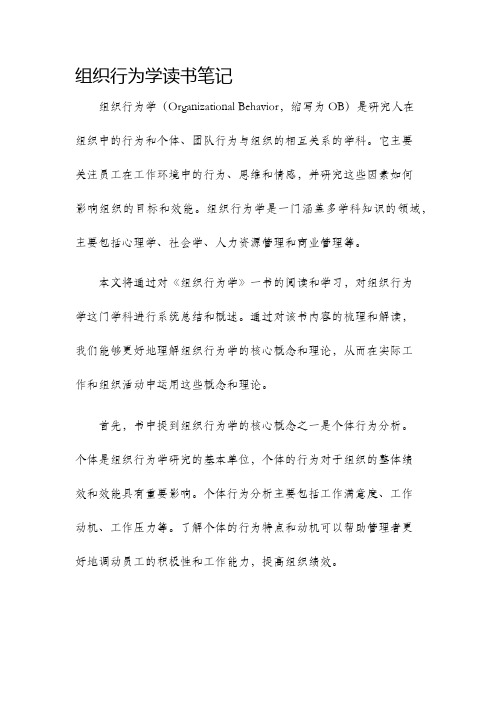
组织行为学读书笔记组织行为学(Organizational Behavior,缩写为OB)是研究人在组织中的行为和个体、团队行为与组织的相互关系的学科。
它主要关注员工在工作环境中的行为、思维和情感,并研究这些因素如何影响组织的目标和效能。
组织行为学是一门涵盖多学科知识的领域,主要包括心理学、社会学、人力资源管理和商业管理等。
本文将通过对《组织行为学》一书的阅读和学习,对组织行为学这门学科进行系统总结和概述。
通过对该书内容的梳理和解读,我们能够更好地理解组织行为学的核心概念和理论,从而在实际工作和组织活动中运用这些概念和理论。
首先,书中提到组织行为学的核心概念之一是个体行为分析。
个体是组织行为学研究的基本单位,个体的行为对于组织的整体绩效和效能具有重要影响。
个体行为分析主要包括工作满意度、工作动机、工作压力等。
了解个体的行为特点和动机可以帮助管理者更好地调动员工的积极性和工作能力,提高组织绩效。
其次,团队行为分析也是组织行为学的重要领域。
团队作为组织的基本单元,团队的协作和协调能力对于组织的成功至关重要。
团队建设和团队领导是团队行为分析的重要内容,这包括如何建立高效的团队、如何激发团队成员的创造力和合作精神等。
通过深入研究团队行为,可以提高团队的工作效率和合作性,实现组织的目标。
另外,组织文化和组织变革也是组织行为学的重要方向。
组织文化是指组织中形成的一种共同的价值观、信念和行为规范,它对于组织成员的行为和决策起到重要的引导作用。
组织变革是指组织在面临外部环境变化时采取的适应性调整和改变。
通过研究组织文化和组织变革,可以帮助组织更好地应对变化和挑战,并保持竞争力。
在组织行为学的研究方法方面,书中介绍了定性和定量研究方法的应用。
定性研究方法主要通过访谈、观察和案例研究等方式收集和分析数据,主要用于深入理解个体和团队行为的本质和动因。
定量研究方法主要通过问卷调查、实验室实验和统计分析等方式收集和分析数据,主要用于验证和推广理论。
组织行为学英语习题(2)

组织行为学英语习题(2)Chapter 15 Foundations of Organization StructureMULTIPLE CHOICEWhat is Organizational Structure?1. _____ defines how job tasks are formally divided, grouped, and coordinated.a. Organizational structureb. Organizational behaviorc. Formalizationd. Span of control(a; Easy; p. 425)2. Organizational structure is made up of six key elements. Which of the following is not one of theseelements?a. centralizationb. departmentalizationc. coordinationd. formalization(c; Moderate; Exh. 15-1; p. 426)3. Work specialization is the same as:a. span of control.b. division of labor.c. unity of command.d. job grouping.(b; Easy; p. 426)4. The degree to which tasks are subdivided into separate jobs is termed:a. departmentalization.c. work specialization.d. span of control.(c; Moderate; p. 426)5. In the late 1940s, most manufacturing jobs in industrialized countries were being done with high:a. departmentalization.b. formalization.c. work specialization.精品d. span of control.(c; Moderate; p. 426)6. For much of the first half of the 20th century, managers viewed _____ as an unending source ofincreased productivity.a. departmentalizationb. formalizationc. work specializationd. span of control(c; Moderate; p. 426)7. Which one of the following components of organizational structure specifically defines wheredecisions are made?a. complexityb. formalizationc. centralizationd. technology(c; Moderate; Exh 15-1; p. 426)8. The basis by which jobs are grouped together is termed:a. departmentalization.c. work specialization.d. centralization.(a; Easy; Exh. 15-1; p. 426)9. Grouping jobs on the basis of function, product, geography, process, or customer is a form of:a. departmentalization.b. work specialization.c. span of control.d. chain of command.(a; Moderate; p. 427)10. One of the most popular ways to group activities is by:a. product.b. function.c. geography.d. process.(b; Challenging; p. 427)精品11. Proctor & Gamble departmentalizes by Tide, Pampers, Charmin, and Pringles. This is an example ofdepartmentalization by:a. function.b. process.c. customer.d. product.(d; Easy; p. 428)12. A manufacturing manager who organizes the plant by separating engineering, accounting,manufacturing, personnel, and purchasing into departments is practicing _____ departmentalization.a. target customerb. productc. functionald. geographic(c; Moderate; p. 428)13. _____ departmentalization achieves economies of scale by placing people with common skills andorientations into common units.a. Functionalb. Processc. Productd. Geographic(a; Moderate; p. 428)14. At an Alcoa aluminum tubing plant in upstate New York, production is organized into fivedepartments: casting; press; tubing; finishing; and inspecting; packing; and shipping. This is an example of _____departmentalization.a. Functionalb. Processc. Productd. Geographic(b; Moderate; p. 428)15. The unbroken line of authority that extends from the top of the organization to the lowest echelonand clarifies who reports to whom is termed:a. chain of command.b. authority.精品c. power.d. unity of command.(a; Moderate; p. 429)16. The right inherent in a managerial position to give orders and expect orders to be obeyed is termed:a. chain of command.b. authority.c. power.d. unity of command.(b; Moderate; p. 429)17. The _____ principle helps preserve the concept of an unbroken line of authority.a. span of controlb. powerc. unity of commandd. decentralization(c; Moderate; p. 429)18. The _____ principle states that a person should have one and only one superior to whom he or she isdirectly responsible.a. span of controlb. chain of commandc. unity of commandd. power(c; Easy; p. 429)19. The _____ refers to the number of subordinates a manager can efficiently and effectively direct.a. span of controlb. unity of commandc. chain of commandd. organizational chart(a; Easy; p. 418)20. Which of the following is a drawback of a narrow span of control?a. It reduces effectiveness.b. It is more efficient.c. It encourages overly tight supervision and discourages employee autonomy.d. It empowers employees.精品(c; Challenging; p. 430)21. Which of the following is not a drawback of a narrow span of control?a.They are expensive.b.They make vertical communication in the organization more complex.c.They encourage employee autonomy.d.They encourage overly tight supervision.(c; Challenging; p. 430)22. The trend in recent years has been toward:a.narrower spans of control.b.wider spans of control.c. a span of control of five.d.an ideal span of control of eight.(b; Moderate; p. 430)23. If you have a narrow span of control, you have a _____ organization.a.multi-levelb.shortc.talld.matrix(c; Moderate; p. 430)24. _____ are consistent with recent efforts by companies to reduce costs, cut overhead, speed updecision making, increase flexibility, get closer to customers, and empower employees.a.Wider spans of controlb.Narrower spans of controlc.Flatter organizationsd.Formalization(a; Moderate; p. 430)25. The best definition for centralization is:a.decision discretion is pushed down to lower level employees.b.decision making is concentrated at a single point in the organization.c.decision making depends on the situation.d.decision making is done in each department and then sent to the president for the final decision. (b; Moderate; p. 431)26. The component of structure which considers where decision-making authority lies is:精品a. delegation.b. formalization.c. complexity.d. centralization.(d; Moderate; p. 431)27. In an organization that has high centralization:a. the corporate headquarters is located centrally to branch offices.b. all top level officials are located within the samegeographic area.c. top managers make all the decisions and lower level managers merely carry out topmanagement’s directions.d. action can be taken more quickly to solve problems.(c; Moderate; p. 431)28. The more that lower-level personnel provide input or are actually given the discretion to makedecisions, the more _____ there is.a. centralizationb. decentralizationc. work specializationd. departmentalization(b; Moderate; p. 431)29. If a job is highly formalized, it would not include which of the following?a. clearly defined procedures on work processesb. explicit job descriptionc. high employee job discretiond. a large number of organizational rules(c; Moderate; p. 431)30. Explicit job descriptions, lots of rules, and clearly defined procedures concerning work processes areconsistent with:a. high formalization.b. technological innovation.c. high centralization.d. an organic model.(a; Challenging; pp. 431-432)31. Employee discretion is inversely related to:a. complexity.精品b. standardization.c. centralization.d. technology.(b; Challenging; p. 432)Common Organizational Designs32. Which of the following is not a common organizational design?a.simple structureb.bureaucracyc.centralized structured.matrix structure(c; Easy; p. 433)33. The _____ is characterized by a low degree of departmentalization, wide spans of control, authority centralized in a single person, and little formalization.a. bureaucracyb. matrix organizationc. simple structured. team structure(c; Moderate; p. 433)34. Which one of the following is consistent with a simple structure?a. high centralizationb. high horizontal differentiationc. high formalizationd. high departmentalization(a; Moderate; p. 433)35. The ____ is a flat organization.a.simple structureb.bureaucracyc.centralized structured.matrix structure(a; Moderate; p. 433)36. Simple structures are characterized by:a. shared authority.精品b. a narrow span of control.c. lots of formalization.d. a low degree of departmentalization.(d; Moderate; p. 433)37. The ___ is most widely practiced in small businesses in which the manager and owner are one and thesame.a.simple structureb.bureaucracyc.centralized structured.matrix structure(a; Moderate; p. 433)38. The bureaucracy is characterized by all of the following except:a. highly routine operating tasks.b. formalized rules and regulations.c. tasks that are grouped into functional departments.d. decentralized decision making.(d; Moderate; p. 434)39. The key underlying all bureaucracies is:a. flexibility.b. standardization.c. dual lines of authority.d. wide span of control.(b; Moderate; p. 434)40. The ____ is characterized by highly routine operating tasks achieved through specialization.a.simple structureb.bureaucracyc.centralized structured.matrix structure(b; Moderate; p. 434)41. The strength of the simple structure lies in its:a.formalization.b.simplicity.精品c.centralization./doc/a912923417.html,rmation processing.(b; Easy; p. 433)42. Which of the following is not a weakness of the simple structure?a.It is risky./doc/a912923417.html,rmation overloadc.accountability is cleard.slower decision making(c; Moderate; p. 433)43. Specialization creates subunit conflicts in the:a.simple structure.b.bureaucracy.c.centralized structure.d.matrix structure.(b; Moderate; p. 434)44. The structure that creates dual lines of authority and combines functional and productdepartmentalization is the:a. simple structure.b. bureaucracy.c. matrix structure.d. virtual organization.(c; Moderate; p. 435)45. The matrix structure combines which two forms of departmentalization?a. simple and functionalb. functional and productc. product and organicd. organic and mechanistic(b; Challenging; p. 435)46. The _____ violates the unity of command concept.a. simple and functionalb. functional and productc. product and organicd. organic and mechanistic(c; Challenging; p. 435)精品47. Which one of the following problems is most likely to occur in a matrix structure?a. decreased response to environmental changeb. decreased employee motivationc. loss of economies of scaled. employees receiving conflicting directives(d; Moderate; p. 436)48. The strength of the matrix structure is its:a. ability to facilitate coordination.b. economies of scale.c. adherence to chain of command.d. predictability.(a; Moderate; p. 436)49. The major disadvantage of the matrix structure is:a. the confusion it creates.b. its propensity to foster power struggles.c. the stress it places on individuals.d. all of the above(d; Challenging; p. 436)New Design Options50. The primary characteristics of the _____ structure are that it breaks down departmental barriers anddecentralizes decision making to the level of the work team.a. virtual organizationb. teamc. boundarylessd. feminine organization(b; Moderate; p. 436)51. In larger organizations, the team structure complements what is typically a:a.virtual organization.b.bureaucracy.c.simple structure.d.boundaryless organization.(b; Challenging; p. 437)精品52. A small, core organization that outsources major business functions is the _____ organization.a. teamb. virtualc. boundarylessd. matrix(b; Moderate; p. 437)53. The ____ is also called the network or modular organization.a.virtual organizationb.team structurec.pyramidd.boundaryless organization(a; Moderate; p. 437)54. The prototype of the virtual structure is today’s:a.automobile manufacturers.b.movie-making organizations.c.fast-food restaurants.d.software companies.(b; Challenging; p. 437)55. The major advantage of the virtual organization is its:a. control.b. predictability.c. flexibility.d. empowerment.(c; Moderate; p. 438)56. The _____ organization stands in sharp contrast to the typical bureaucracy that has many verticallevels of management and where control is sought through ownership.a. virtualb. teamc. limitlessd. matrix(a; Challenging; p. 438)57. The boundaryless organization relies heavily on:/doc/a912923417.html,rmation technology.b.vertical boundaries.精品c.horizontal boundaries.d.external barriers.(a; Moderate; p. 438)58. An organization that seeks to eliminate the chain of command, have limitless spans of control, andreplace departments with empowered teams is the:a. virtual organization.b. boundaryless organization.c. matrix organization.d. team structure.(b; Moderate; p. 438)59. The one common technological thread that makes the boundaryless organization possible is:a. reengineering.b. MBA’s.c. networked computers.d. mainframes.(c; Moderate; p. 439)Why Do Structures Differ?60. The _____ is a structure characterized by extensivedepartmentalization, high formalization, a limitedinformation network, and centralization.a. mechanistic modelb. organic modelc. technology modeld. boundaryless organization(a; Moderate; p. 440)61. Which of the following is not a characteristic of a mechanistic structure?a. extensive departmentalizationb. high formalizationc. limited information networkd. flexibility(d; Easy; p. 440)62. If there is low formalization, a comprehensive information network, and high participation in decisionmaking, one would expect a(n):a. bureaucracy.精品b. mechanistic structure.c. organic structure.d. stable structure.(c; Challenging; p. 440)63. All of the following are characteristics of the organic model except:a. cross-functional teams.b. rigid departmentalization.c. cross hierarchical teams.d. free flow of information.(b; Moderate; p. 440)64. Which of the following is not a deter minant of an organization’s structure?a.strategy/doc/a912923417.html,anization sizec.industryd.technology(c; Moderate; pp. 440-444)65. Changes in corporate strategy precede and lead to:a. changes in the environment.b. better communication.c. increased productivity.d. changes in an organization’s structure.(d; Challenging; p. 440)66. A strategy that emphasizes the introduction of major new products and services is a(n) _____ strategy.a. innovationb. cost-minimizationc. imitationd. organic(a; Moderate; p. 441)67. The innovation strategy is characterized by:a. avoiding unnecessary costs.b. a mixture of loose with tight properties.c. low specialization and low formalization.d. tight controls over current activity.(c; Challenging; p. 441)精品68. _____ refers to how an organization transfers its inputsinto outputs.a.Imitationb.Technologyc.Operationsd.Innovation(b; Moderate; p. 441)69. Which of the following is not part of the organization’s environment?a.public pressure groupsb.customersc.technology/doc/a912923417.html,petitors(c; Easy; p. 443)70. The _____ of an environment refers to the degree to which it can support growth.a. capacityb. volatilityc. complexityd. nurturance(a; Moderate; p. 443)71. _____ refers to the degree of instability of an environment.a. Capacityb. Volatilityc. Complexityd. Equilibrium(b; Easy; p. 443)72. Three key dimensions to any organization’s environment have been found. Which of the following is not one of these key dimensions?a. volatilityb. capabilityc. complexityd. capacity(b; Moderate; p. 443)73. The _____ of an environment refers to the degree of heterogeneity and concentration amongenvironmental elements.a. capacity精品b. volatilityc. complexityd. creativity(c; Moderate; p. 443)Organization Designs and Employee Behavior74. Which of the following generalizations about organizational structures and employee performance and satisfaction is most true?a. There is fairly strong evidence linking decentralization and job satisfaction.b. It is probably safe to say that no evidence supports a relationship between span of control andemployee performance.c. The evidence generally indicates that work specialization contributes to lower employeeproductivity.d. No one wants work that makes minimal intellectual demands and is routine.(b; Challenging; pp. 445-446)75. _____ models of organizational structure are perceptionsthat people hold regarding structuralvariables formed by observing things around them in an unscientific fashion.a. Explicitb. Implicitc. Strategicd. Intuitive(b; Challenging; p. 447)TRUE/FALSE76. Organizations have different structures, but the structure has little bearing on employee attitudes andbehavior.(False; Easy; p. 425)What is Organizational Structure?77. Specialization defines how job tasks are formally defined, grouped, and coordinated.(False; Moderate; p. 426)78. Managers need to address six key elements when they design their organization’s structure: workspecialization, departmentalization, chain of command, span of control, centralization and decentralization, and formalization.(True; Moderate; p. 426)精品79. The degree to which tasks in the organization are subdivided into separate jobs is termeddepartmentalization.(False; Moderate; p. 426)80. Work specialization and division of labor are the same thing.(True; Easy; p. 426)81. Work specialization can be carried too far and may result in employee boredom, stress, andabsenteeism.(True; Moderate; p. 427)82. For much of the first half of this century, managers viewed departmentalization as an unendingsource of increased productivity.(False; Moderate; p. 427)83. The strength of functional departmentalization is putting similar specialists together.(True; Moderate; p. 428)84. Organizations may choose only one of the forms of departmentalization at a time.(False; Moderate; p. 429)85. The inherent right in a managerial position to give orders and expect the orders to be obeyed istermed authority.(True; Moderate; p. 429)86. Departmental ization answers questions for employee such as “To whom do I go if I have aproblem?”(False; Moderate; p. 429)87. The unbroken line of authority that extends from the top of the organization to the lowest echelon istermed the chain of command.(True; Easy; p. 429)88. The principle of unity of command suggests that managers should back one another up when adirective has been given.(False; Challenging; p. 429)89. The trend in recent years has been toward wider spans of control.(True; Easy; p. 430)90. Span of control determines the number of levels and managers an organization has.精品。
组织行为学讲义

组织行为学讲义组织行为学复习资料一、组织行为学Organizational behavior (OB) :研究个体、群体和组织结构对组织内行为的影响,其主要目的是利用组织行为学的相关知识来提高组织的效能。
二、组织行为学对组织中出现的行为进行:预测解释控制引导三、系统性研究:是通过观察人们之间的关系、试图定位因果何在并根据科学证据作出结论。
四、对组织行为学相关有贡献的学科:(1)心理学 Psychology 是一门对人和其他动物的行为进行测量和解释,有时还包括对行为进行改变的科学,它关心的是研究和理解个体的行为。
(2)社会学 Sociology 研究的是与其他人发生联系的人。
(3)社会心理学 Social Psychology 心理学和社会学相结合的产物,关注人与人之间的相互影响。
(4)人类学 Anthropology 研究社会以认识人类及其活动。
五、劳动力多元化: 组织正转化成包括不同性别、年龄、种族、民族以及不同性取向的更多元化的混合体。
分类有(性别人种国籍年龄残疾家庭成员宗教信仰)六、权变变量Contingency variables: “It Depends" 环境因素使两变量间的主要关系发生变化:在一定条件下成立的关系在其他条件下未必成立。
七、组织行为学的研究方法:实验室实验法自然实验法现场调查法现场观察法案例研究法。
八、表层多元化——年龄、民族、性别、宗教信仰等方面的不同深层多元化——人格和价值观方面的不同九、年龄:随着年龄增长工作绩效可能会下降劳动力整体呈现老龄化强制退休年龄将不受法律保护年龄越大,离职的可能性就越小。
总的来说,年长的员工比年轻的员工在可避免的缺勤上比率更低,在不可避免的缺勤上,两者比率是一样的。
年龄与工作绩效没什么关系。
年长的员工对工作满意度更高对雇主承诺更高,呈U型关系。
十、性别Gender :在传统男性领域中成功的女性不受人喜欢、具有敌意,作为主管不被欢迎;全职妈妈更喜欢兼职工作、灵活的工作时间、远程办公;女性的缺勤率和离职率更高。
罗宾斯《组织行为学第16版》完整学习笔记
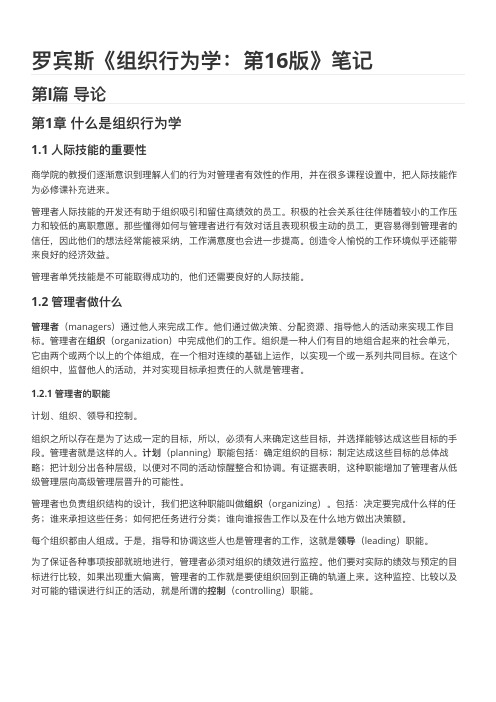
罗宾斯《组织⾏为学:第16版》笔记第Ⅰ篇导论第1章什么是组织⾏为学1.1 ⼈际技能的重要性商学院的教授们逐渐意识到理解⼈们的⾏为对管理者有效性的作⽤,并在很多课程设置中,把⼈际技能作为必修课补充进来。
管理者⼈际技能的开发还有助于组织吸引和留住⾼绩效的员⼯。
积极的社会关系往往伴随着较⼩的⼯作压⼒和较低的离职意愿。
那些懂得如何与管理者进⾏有效对话且表现积极主动的员⼯,更容易得到管理者的信任,因此他们的想法经常能被采纳,⼯作满意度也会进⼀步提⾼。
创造令⼈愉悦的⼯作环境似乎还能带来良好的经济效益。
管理者单凭技能是不可能取得成功的,他们还需要良好的⼈际技能。
1.2 管理者做什么管理者(managers)通过他⼈来完成⼯作。
他们通过做决策、分配资源、指导他⼈的活动来实现⼯作⽬标。
管理者在组织(organization)中完成他们的⼯作。
组织是⼀种⼈们有⽬的地组合起来的社会单元,它由两个或两个以上的个体组成,在⼀个相对连续的基础上运作,以实现⼀个或⼀系列共同⽬标。
在这个组织中,监督他⼈的活动,并对实现⽬标承担责任的⼈就是管理者。
1.2.1 管理者的职能计划、组织、领导和控制。
组织之所以存在是为了达成⼀定的⽬标,所以,必须有⼈来确定这些⽬标,并选择能够达成这些⽬标的⼿段。
管理者就是这样的⼈。
计划(planning)职能包括:确定组织的⽬标;制定达成这些⽬标的总体战略;把计划分出各种层级,以便对不同的活动惊醒整合和协调。
有证据表明,这种职能增加了管理者从低级管理层向⾼级管理层晋升的可能性。
管理者也负责组织结构的设计,我们把这种职能叫做组织(organizing)。
包括:决定要完成什么样的任务;谁来承担这些任务;如何把任务进⾏分类;谁向谁报告⼯作以及在什么地⽅做出决策额。
每个组织都由⼈组成。
于是,指导和协调这些⼈也是管理者的⼯作,这就是领导(leading)职能。
为了保证各种事项按部就班地进⾏,管理者必须对组织的绩效进⾏监控。
组织行为学

McShane/Von Glinow OB4e
Slide 1-12
© 2008 The McGraw-Hill Companies, Inc. All rights reserved.
Corporate Social Responsibility
• Corporate Social Responsibility
Multidisciplinary Anchor
Systematic Research Anchor
Open Systems Anchor
Organizational Behavior Anchors
Multiple Levels of Analysis Anchor
Contingency Anchor
McShane/Von Glinow OB4e
Slide 1-9
© 2008 The McGraw-Hill Companies, Inc. All rights reserved.
Values-based Leadership in Dubai
The Department of Economic Development (DED) in the Emirate of Dubai recently devoted several months to identifying the agency’s core values: accountability, teamwork, and continuous improvement. DED also organized a series of workshops (shown in photo) to help employees recognize values-consistent behaviors.
组织行为学精要第十版chapter7 emotions and moods

Emotion
Intense feelings that are directed at someone or something Short termed and action-oriented.
Mood
Feelings that tend to be less intense and longer-lasting than emotions and often lack a contextual stimulus
Even More Sources
Exercise
Mildly enhances positive mood
Age
Older people experience negative emotions less frequently
Gender
Women show greater emotional expression, experience emotions more intensely and display more frequent expressions of emotions Could be due to socialization
Copyright ©2010 Pearson Education, Inc.
7-10
More Sources
Weather
No impact according to research
Stress
Increased stress worsens moods
Social Activities
Copyright ©2010 Pearson Education, Inc. 7-3
Emotional Terminology
组织行为学
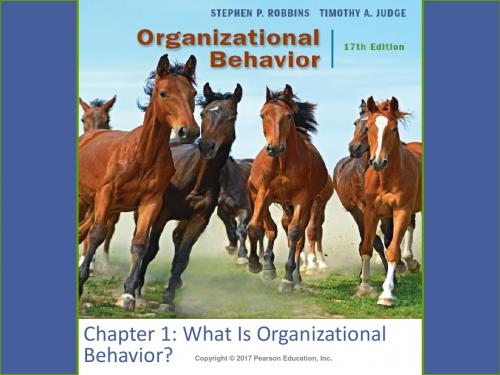
Copyright © 2017 Pearson Education, Inc.
1-1
Learning Objectives
1. Demonstrate(证明) the importance of interpersonal skills in the workplace. 2. Define organizational behavior (OB). 3. Show the value to OB of systematic study. 4. Identify the major behavioral science disciplines (行为科学学科)that contribute to OB. 5. Demonstrate why few absolutes apply to OB. 6. Identify managers‘ challenges and opportunities in applying OB concepts. 7. Compare the three levels of analysis in this text‘s OB model.
Copyright © 2017 Pearson Education, Inc.
1-7
LO 2
Effective versus successful managerial activities
Luthans(卢森斯)and his associates found that all managers engage in four managerial activities:
There is a strong association between the quality of workplace relationships and job satisfaction, stress, and turnover. It fosters(培养)social responsibility awareness.
组织行为学 经典教材
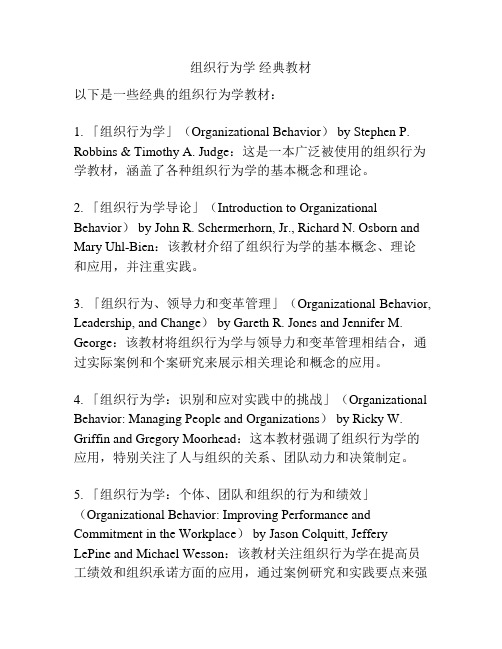
组织行为学经典教材以下是一些经典的组织行为学教材:1. 「组织行为学」(Organizational Behavior) by Stephen P. Robbins & Timothy A. Judge:这是一本广泛被使用的组织行为学教材,涵盖了各种组织行为学的基本概念和理论。
2. 「组织行为学导论」(Introduction to Organizational Behavior) by John R. Schermerhorn, Jr., Richard N. Osborn and Mary Uhl-Bien:该教材介绍了组织行为学的基本概念、理论和应用,并注重实践。
3. 「组织行为、领导力和变革管理」(Organizational Behavior, Leadership, and Change) by Gareth R. Jones and Jennifer M. George:该教材将组织行为学与领导力和变革管理相结合,通过实际案例和个案研究来展示相关理论和概念的应用。
4. 「组织行为学:识别和应对实践中的挑战」(Organizational Behavior: Managing People and Organizations) by Ricky W. Griffin and Gregory Moorhead:这本教材强调了组织行为学的应用,特别关注了人与组织的关系、团队动力和决策制定。
5. 「组织行为学:个体、团队和组织的行为和绩效」(Organizational Behavior: Improving Performance and Commitment in the Workplace) by Jason Colquitt, Jeffery LePine and Michael Wesson:该教材关注组织行为学在提高员工绩效和组织承诺方面的应用,通过案例研究和实践要点来强调关键概念和技能。
OrganizationBehavior组织行为学

OrganizationBehavior组织⾏为学Organization BehaviorChapter1/doc/ad25610c4a7302768e9939d1.html anizational behavior (OB):A field of study that investigates the impact that individuals, groups and structure have on behavior within organization, for the purpose of applying such knowledge toward improving an organization’s effectiveness2. Managers doManagement functionPlanningA process that includes defining goals, establishingstrategy(策略), and developing plans to coordinate(调整)activitiesControllingMonitoring activities to ensure they are beingaccomplished as planned and correcting anysignificant deviations(背离).OrganizingDetermining what tasks are to be done, who is todo them, how the tasks are to be grouped, whoreports to whom, and where decisions are to bemade.LeadingA function that includes motivating employees,directing others, selecting the most effectivecommunication channels, and resolving conflictsManagement role: 1) interpersonal(⼈际⾓⾊)Figurehead(头⾯⼈物) Leader(领导者) Liaison(联络⼈)2) informational(信息传递者)Monitor(监控者) Disseminator(传递者) Spokesperson(发⾔⼈)3) Decisional(决策⾓⾊)Entrepreneur(创业者) Disturbance handler(混乱处理者)Resource allocator(资源分配者) Negotiator(谈判者)Management skills: 1) Technical skillsThe ability to apply specialized knowledge or expertise(专门技术).2) Human skillsThe ability to work with, understand, and motivate other people, both individually and in groups.3) Conceptual skillsThe mental ability to analyze and diagnose(诊断) complex situations. 3. Effective versus Successful Managerial Activities 1) Traditional managementDecision making, planning, and controlling2) CommunicationExchanging routine(例⾏的) information and processing paperwork3) Human resource managementMotivating, disciplining, managing conflict, staffing(⼈员指挥), and training4) NetworkingSocializing, politicking(政治活动), and interacting(相互影响) with others4. Challenges and Opportunities for OB1) Responding to GlobalizationIncreased foreign assignmentsWorking with people from different culturesOverseeing movement of jobs to countries with low-cost labor2) Managing Workforce Diversity(差异,多样性)Embracing diversityChanging demographics(⼈⼝)Implications for managersRecognizing and responding to differences3) Improving Quality and ProductivityQuality management (QM)Process reengineering4) Responding to the Labor ShortageChanging work force demographicsFewer skilled laborersEarly retirements and older workers5) Improving Customer ServiceIncreased expectation of service qualityCustomer-responsive cultures6) Improving People Skills7) Empowering(授权) People8) Stimulating(刺激) Innovation(改⾰) and Change9) Coping with “Temporariness(临时性)”10) Working in Networked Organizations11) Helping Employees Balance Work/Life Conflicts12) Improving Ethical(伦理的) Behavior5. Independent and dependent variables1) individual-level variables个体⽔平变量⼈们带着不同的特点进⼊组织,这些特点将影响到他们在⼯作中的⾏为。
组织行为学精要第十版chapter5 motivation concepts
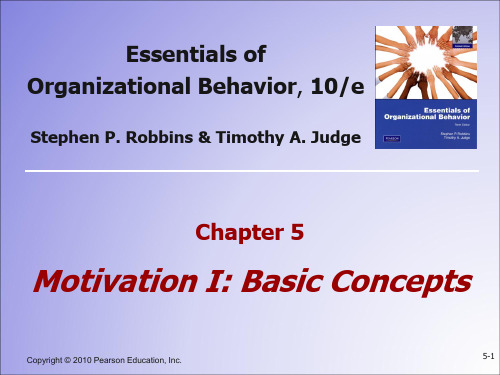
Comments on Traditional Motivation Theories
• Maslow’s theories appear to be intuitively valid, but there is no research evidence to support them; they’re merely of historical interest. No research evidence shows that either theory X or Y is valid or that taking actions based on Theory Y will increase motivation in workers. Herzberg, too, is not well supported in the research literature. McClellan’s theory has the best research support, but has the least practical effect of any of the early motivational theories.
5-12
•
Copyright ©2010 Pearson Education, Inc.
Goal-Setting Theory
• Goals increase performance when the goals are:
Specific Difficult, but accepted by employees Accompanied by feedback (especially selfgenerated feedback)
罗宾斯_组织行为学(第十版)_课后习题答案详解

第1章什么是组织行为学1.l 复习笔记一、管理者做什么管理者通过别人来完成工作,他们做出决策、分配资源、指导别人的活动从而实现工作目标。
1. 管理者的职能20世纪初,法国工业家亨利·法约尔(Henri Fayol)提出,所有的管理者都发挥五种职能:计划、组织、指挥、协调和控制。
今天这些职能简化为四种:计划、组织、领导和控制。
(1)计划计划活动就是要设定或明确组织的目标,制定实现组织目标的途径或方案。
(2)组织为了实现计划活动所预定的目标,实施计划活动制定的行动方案。
(3)领导管理者就运用各种适当的方法,去影响组织的成员,努力营造起一种使组织中的成员能够全心全意、士气高昂地为实现组织目标而努力奋斗的氛围,以便使管理的领导职能得到更大的发挥。
(4)控制为了确保组织目标的顺利实现,组织的管理者从头到尾地对组织各项活动的进展情况进行检查,一旦发现或预见问题后就要及时采取措施予以纠正,以保证组织活动按计划进行。
2. 管理者的角色20世纪60年代末,麻省理工学院(MIT)的研究生亨利·明茨伯格对5位高层经理进行了一项精心研究,明茨伯格得出结论:管理者扮演着10种不同的但又互相关联的角色。
这10种角色可以归纳为三大类:人际角色、信息传递者角色以及决策角色。
(1)人际关系方面的角色人际关系角色指所有的管理者都要履行礼仪性和象征性角色。
(2)信息传递方面的角色信息角色是指所有的管理者在某种程度上,都从外部的组织或机构接受和收集信息。
(3)决策制定方面的角色在决策角色中,管理者处理信息并得出结论。
亨利·明茨伯格界定的10种管理角色如表1.1所示。
3. 管理者的技能罗伯特·卡茨(Robert Katz)提出了三种基本的管理技能:技术技能、人际技能和概念技能。
(1)技术技能技术技能,指为了完成或理解一个组织的特定工作所必需的技能,也就是业务方面的技能。
(2)人际技能人际技能,指与组织单位中上下左右的人打交道的能力。
组织行为学-英语习题-(4)

Chapter 1 What Is Organizational Behavior?MULTIPLE CHOICE1. Successful managers and entrepreneurs recognize that:a. technical knowledge is all that is needed for success.b. interpersonal skills are not important.c. technical skills are necessary, but insufficient, for succeeding in management.d. an understanding of human behavior does not impact effectiveness(c; Challenging; pp. 2-3)What Managers Do2. Which one of the following is not considered an organization?a. churchb. universityc. a military unitd. all 45-year-old adults in a community(d; Easy; p. 4)3. A(n) _____ is a consciously coordinated social unit, composed of two or more people, that functionson a relatively continuous basis to achieve a common goal or set of goals.a. organizationb. unitc. teamd. ethnic group(a; Moderate; p. 4)4. The four management functions include all of the following except:a. controlling.b. planning.c. staffing.d. organizing.(c; Moderate; p. 4)5. _____ includes defining an o rganization’s goals and establishing an overall strategy for achievingthese goals and developing a comprehensive hierarchy of plans to integrate and coordinate activities.a. Controllingb. Planningc. Leadingd. Coordinating(b; Moderate; p. 4)6. The determination of how tasks are to be grouped is part of which management function?a. planningb. leadingc. controllingd. organizing(d; Easy; p. 4)7. The organizing function includes a determination of which of the following?a.what tasks are to be doneb.who is to do these tasksc.who reports to whomd.all of the above(d; Moderate; p. 4)8. Every organization contains people, and it is management’s job to direct and coordinate these people.This is the ______ function.a.planningb.leadingc.controllinganizing(b; Moderate; p.4)9. According to Henry Mintzberg, the ten managerial roles can be grouped into three categories.Which of the following is not one of these groups?a. concern with the interpersonal relationshipsb. the transfer of informationc. decision makingd. liaison roles(d; Challenging; Exh. 1-1; p. 6. )10. An example of Mintzberg’s interpersonal management role is:a. spokesperson.b. leader.c. negotiator.d. monitor.(b; Moderate; Exh. 1-1; p. 6)11. When a manager searches the organization and its environment for opportunities and initiates projectsto bring about change, the manager is acting in which role?a. negotiatorb. entrepreneurc. disturbance handlerd. resource allocator(b; Challenging; Exh. 1-1; p. 6)12. Which of the following is not an essential management skill identified by Robert Katz?a.technicalputerc.humand.conceptual(b; Moderate; p. 5)13. When managers have the mental ability to analyze and diagnose complex situations, they possess:a.technical skills.puter skills.c.human skills.d.conceptual skills.(d; Challenging; pp. 6-7 )14. Which one of the following would not be considered a human skill?a. completing accounting reportsb. communicatingc. resolving conflictsd. working as part of a team(a; Moderate; pp 5-6)15. According to Luthans and his associates, which of the following is not considered a part of traditionalmanagement?a. interacting with outsidersb. decision makingc. controllingd. planning(a; Moderate; p. 7)16. Which of Luthan’s managerial activities involves socializing, politicking, and interacting withoutsiders?a.traditional managementmunicationc.human resource managementworking(d; Challenging; p. 7 )17. According to Luthans, successful managers spent more of their time on _____ than on any otheractivity.a.traditional managementb.human resource managementworkingmunicating(c; Challenging; p. 8)18. A common thread running through the functions, roles, skills, and activities approaches tomanagement recognizes the importance of:a.managing technology.b.managing people.c.politicking.d.being efficient.(b; Moderate; p. 8)Enter Organizational Behavior19. Organizational behavior is all of the following except:a. a field of study.b. an applied field.c. an intuitive analysis of human behavior.d. studying what people do in an organization.(c; Moderate; p. 8)20. ______ is a field of study that investigates the impact that individuals, groups, and structure haveon behavior within organizations for the purpose of applying such knowledge toward improving an organization’s effectiveness.anizational developmentb.Managementanizational behaviord.People management(c; Easy; p. 8)21. Which of the following is not a core topic of organizational behavior?a.motivationb.attitude developmentc.conflictputers(d; Easy; p. 8 )22. According to the text, the best approach for obtaining knowledge about human behavior isa. the common sense approach.b. an observational approach.c. a systematic approach.d. a theoretical approach.(c; Easy; p. 10)23. A major theme in your textbook is that behavior is not:a. caused.b. random.c. consistent.d. predictable.(b; Easy; p. 9)24. If we know how a person perceives a situation and what is important to him/her, then behavior isgenerallya. predictable.b. predetermined.c. uncontrollable.d. controllable.(a; Moderate; p. 9)25. Fundamental consistencies allow _____ of behavior.a. observationb. systematizingc. researchd. predictability(d; Moderate; pp. 9-10)26. Behavior is generally _____ and the _____ of behavior is a means to making reasonably accuratepredictions.a. predetermined; observationb. predictable; systematic studyc. controllable; theoretical applicationd. uncontrollable; systematic study(b; Moderate; p. 10)27. _____ includes analyzing relationships, determining causes and effects, and basing conclusions onscientific evidence.a. Organizational behaviorb. The observational approach to understanding organizational behaviorc. A theoretical approach to organizational behaviord. A systematic study of organizational behavior(d; Moderate; p. 10)28. In the study of OB, intuition is replaced by:a. systematic study.b. generalization.c. listening.d. prediction.(a; Easy; p. 10)Contributing Disciplines to the OB Field29. Organizational behavior is built upon contributions from all of the following disciplines except:a. humanities.b. psychology.c. anthropology.d. political science.(a; Moderate; p. 11)30. The science that seeks to measure, explain, and sometimes change the behavior of humans and otheranimals is:a. psychiatry.b. psychology.c. sociology.d. political science.(b; Moderate; p. 12)31. Which behavioral science discipline has made the most significant contribution to understandingindividual behavior?a. sociologyb. social psychologyc. psychologyd. anthropology(c; Moderate; p. 12)32. The OB topic of motivation has been most influenced by which behavioral science discipline?a. psychologyb. social psychologyc. sociologyd. political science(a; Moderate; p. 12)33. The most significant contribution to OB in the area of formal organization theory and structure hasbeen made by:a. psychology.b. sociology.c. anthropology.d. political science.(b; Moderate; p. 12)34. _____ studies people in relation to their fellow human beings.a.Psychologyb.Sociologyc.Anthropologyd.Political science(b; Moderate; p. 12)35. The science that focuses on the influence of people on one another is:a. psychology.b. anthropology.c. political science.d. social psychology.(d; Moderate; p. 12)36. One of the major areas receiving considerable investigation from social psychologists has been:a.change.b.motivation.c.job satisfaction.d.job stress.(a; Challenging; p. 12 )37. The OB subject of “organizational culture” has been most influenced by which behavioral sciencediscipline?a. anthropologyb. psychologyc. social psychologyd. political science(a; Moderate; p. 12)38. _____ has helped us understand differences in fundamental values, attitudes, and behavior betweenpeople in different countries.a.Anthropologyb.Psychologyc.Social psychologyd.Political science(a; Challenging; p. 12)39. Topics of study in political science include all of the following except:a. structuring of conflict.b. the social system in which individuals fill their roles.c. allocation of power.d. how people manipulate power for individual self interest.(b; Challenging; p. 12)There are Few Absolutes in OB40. Which of the following is the best description of OB’s current state?a. It is based on universal truths.b. It is based on contingencies.c. There is little disagreement among OB researchers and scholars.d. Cause-effect principles have been isolated which tend to apply to all situations.(b; Moderate; p. 13)Challenges and Opportunities for OB41. Whereas _____ focuses on differences between people from different countries, _____ addressesdifferences among people within given countries.a. workforce diversity; globalizationb. globalization; workforce diversityc. culture; diversityd. culturization; workforce diversity(b; Challenging; pp. 14-15)42. ______ means that organizations are becoming more heterogeneous in terms of gender, race, andethnicity.a.Globalizationb.Workforce diversityc.Affirmative actionanizational culture(b; Easy; p. 15)43. The ________ assumption is being replaced by one that recognizes and values _____.a.melting pot; differencesb.melting pot; similaritiesc.diversity; differencesd.heterogeneous; similarities(a; Moderate; p. 15)44. Which of the following is not true?a. Currently, 46 percent of the U.S. labor force are women.b. Minorities and immigrants make up 23 percent of the workforce.c. The male Caucasian working full time to support a non-employed wife and school-aged children isa minority.d. The proportion of minorities and women is shrinking.(d; Challenging; p. 15)45. The implications of workforce diversity include all of the following except:a.managers have to shift their philosophy from treating everyone alike to recognizing differences.b.diversity training should be provided.c.revamping benefit programs is needed to accommodate the different needs of differentemployees.d.the same perceptions are used in decision making.(d; Challenging; p. 15)46. _____ is a philosophy of management that is driven by the constant attainment of customersatisfaction through the continuous improvement of all organizational processes.a. MBOb. Quality managementc. Reengineeringd. Organizational behavior(b; Easy; p. 16)47. Quality management requires _____ employee involvement.a. very littleb. occasionalc. extensived. no(c; Moderate; p. 16)48. _____ asks managers to reconsider how work would be done and their organization structured if theywere starting over.a. Process reengineeringb. MBOc. TQMd. Diversity training(a; Easy; p. 16)49. Predictions suggest there will be a labor shortage for at least another:a.1-2 years.b.4-5 years.c.10-15 years.d.20-25 years.(c; Moderate; p.17)50. The U.S. labor shortage is a function of:a.birth rates and labor participation rates.b.birth rates and mobility.c.brain drain.d.poor wages and benefits.(a; Moderate; p. 17)51. Many employees have been led to retire early as a result of:a.expanded Social Security benefits.b. a healthy stock market.c.improved pension plans.d.all of the above(d; Challenging; p. 17)52. The majority of employees today in developed countries work in:a.manufacturing jobs.b.service jobs.c.MNCs.ernment agencies.(b; Moderate; p. 18)53. When managers put employees in charge of what they do, they are _____ the employees.a.reengineeringb.empoweringc.diversifyingd.dehiring(b; Moderate; p. 19)54. Managing today can be described as long periods of ongoing _____ interrupted occasionally by shortperiods of _____.a.change; stabilityb.stability; changec.flexibility; rigidityd.rigidity; flexibility(a; Moderate; p. 19)55. Which of the following has not contributed to blu rring the lines between employees’ work life andpersonal life?a.the creation of global organizationsmunications technology allowing employees to work any time and from any placeanizations asking employees to put in longer hoursd.fewer dual-income couples(d; Easy; p. 20)56. Situations where an individual is required to define right and wrong conduct are termed:a. diversity issues.b. human resource problems.c. ethical dilemmas.d. loyalty oaths.(c; Easy; p. 21)Coming Attractions: Developing an OB Model57. A model is a(an):a. abstraction of reality.b. response that is affected by an independent variable.c. independent variable.d. real-world scenario.(a; Easy; p. 22)58. Primary dependent variables in OB include:a. productivity.b. absenteeism.c. job satisfaction.d. all of the above(d; Easy; p. 23)59. _____ is achievement of goals.a. Efficiencyb. Effectivenessc. Productivityd. Motivation(b; Easy; p. 23)60. Which of the following is an example of being an efficient company or employee?a. operating a hospital at the lowest possible cost but still yielding a high profitb. being the most pleasant real estate broker in the southeastc. as a telemarketer, making the required number of calls at the end of the dayd. a sales person who acquires the most clients of anyone in the company(a; Challenging; p. 23)61. Sears trained employees to improve the employee-customer interaction to ultimately:a.generate additional revenue.b.decrease returns.c.improve repeat customer business.d.none of the above(a; Moderate; p. 23)62. _____ is discretionary behavior that is not part of an employee’s formal job requirement, but thatpromotes the effective functioning of the organization.a.Productivityb.Motivationanizational citizenshipanizational behavior(c; Moderate; p. 25)63. Individual-level independent variables include:a. technology.b. organizational culture.c. perception.d. human resource policy.(c; Moderate; pp. 25-26)64.________ is the voluntary and involuntary permanent withdrawal from an organization.a.Absenteeismb.Turnoverc.Downsizingd.Exit(b; Easy; p. 24)TRUE/FALSE65. The single biggest reason for the failure of managers is poor interpersonal skills.(True; Easy; p. 3)66. While managers must be technically competent, technical knowledge is not enough for success. (True; Moderate; p. 3)What Managers Do67. Managers get things done through other people.(True; Easy; p. 4)68. The term organization, as used in your textbook, is meant to include business firms but excludegovernment agencies.(False; Easy; p. 4)69. Managers may be referred to as administrators in not-for-profit organizations.(True; Moderate; p. 4)70. Henri Fayol listed five management functions: planning, organizing, commanding, coordinating, andcontrolling.(True; Moderate; p. 4)71. Modern theorists have condensed Fayol’s five management functions down to four: planning,organizing, commanding, and controlling.(False; Moderate; p. 4)72. The controlling function includes the determination of what tasks are to be done.(False; Moderate; p. 4)73. Monitoring, comparing, and potential correcting is what is meant by the controlling process. (True; Moderate; p. 4)74. Mintzberg concluded that managers perform ten different highly-interrelated roles, or sets ofbehaviors, attributable to their jobs.(True; Challenging; p. 5)75. The role of spokesperson is an example of an informational role.(True; Easy; p. 5)76. As resource allocators, managers are responsible for allocating human, physical, and monetaryresources.(True; Moderate; Exh. 1-1; p. 6)77. When managers initiate and oversee new projects that will improve their organization’s performance,they are acting in the capacity of an entrepreneur, an example of an informational role.(False; Moderate; Exh. 1-1; p. 6)78. Robert Katz has identified three essential management skills: technical, human, and conceptual. (True; Moderate; pp. 5-6)79. According to Katz, human skills encompass the ability to apply specialized knowledge or expertise. (False; Moderate; pp. 5-6)80. The ability to analyze and diagnose complex situations is referred to as an individual’s conceptualskills.(True; Easy; pp. 6-7)81. According to Luthans and his associates, those managers who are most “successful” will spend moretime networking than those managers who are considered most “effective.”(True; Challenging; Exh. 1-2; p. 7)82. Research conducted by Luthans supports the theory that promotions are based on performance. (False; Moderate; p. 7)83. Luthans’ research indicates that among effective managers, communication made the largest relativecontribution and networking the least.84. Managers need to develop their people skills if they are going to be effective and successful. (True; Moderate; p. 8)Enter Organizational Behavior85. Organizational behavior is a field of study that investigates the impact that individuals, groups, andstructure have on behavior within organizations, for the purpose of applying such knowledge toward improving an organization’s effectiveness.(True; Moderate; p. 8)86. Organizational behavior is concerned with the study of what people do in an organization and how that behavior affects the performance of the organization.(True; Moderate; p. 8)87. Behavior is generally predictable, and the systematic study of behavior is a means to makingreasonably accurate predictions.(True; Moderate; p. 10)88. Many people’s views on human behavior are based on intuition.(True; Easy; pp. 9-10)89. It is the consistencies in behavior that make prediction possible.(True; Moderate; p. 9)90. Regardless of appearances, people usually intend their behavior to be rational.(True; Moderate; p. 9)91. Anything you learn in an unsystematic way is incorrect.(False; Moderate; p. 10)92. Intuition is gut feelings about “why I do what I do.”(True; Easy; p. 10)Contributing Disciplines to the OB Field93. OB is an applied behavioral science that is built upon contributions from a number of behavioraldisciplines.(True; Easy; p. 11)94. Learning, perception, and personality have been OB topics whose contributions have generally comefrom psychology.(True; Moderate; Exh. 1-3; p. 11)(True; Moderate; p. 12)96. Social psychology is an area within psychology, blending concepts from both psychology andpolitical science.(False; Moderate; p.12)97. Anthropology has helped us understand differences in values and attitudes between people in differentcountries.(True; Moderate; p. 12)98. Conflict and power have been major topics of concern to political scientists.(True; Easy; Exh. 1-3; p. 12)There are Few Absolutes in OB99. There are many simple and universal principles that explain organizational behavior.(False; Easy; p. 13)100. OB researchers cannot offers reasonably accurate explanations of human behavior since people act very differently in the same situation.(False; Moderate; p. 13)Challenges and Opportunities for OB101. As the world has become a global village, managers have to become capable of working with people from different cultures.(True; Moderate; p. 14)102. Workforce diversity means that organizations are becoming more homogeneous in terms of gender, race, and ethnicity.(False; Moderate; p. 15)103. People must set aside their cultural values when they come to work.(False; Moderate; p. 15)104. 46 percent of the U.S. labor force are women.(True; Challenging; p. 15)105. Diversity, if positively managed, can increase creativity and innovation in organizations.(True; Easy; p. 15)106. A philosophy of management that is driven by the constant attainment of customer satisfaction through the continuous improvement of all organizational pro cesses is termed “reengineering.”(False; Moderate; p. 16)107. Quality management has an intense focus on the customer and a goal of employee empowerment.108. Putting employees in charge of what they do is termed “reengineering.”(False; Easy; p. 16)109. Process reengineering asks, “How would we do things around here if we were starting over from scratch?”(True; Easy; p. 16)110. In tight labor markets, those managers who don’t understand human behavior risk having no one to manage.(True; Moderate; p. 17)111. An employee who is empowered is given greater opportunity to determine how she does her job. (True; Moderate; p. 19)112. There’s a blurring between the roles of managers and workers.(True; Moderate; p. 20)113. Managing today is described as long periods of ongoing change, interrupted occasionally by short periods of stability.(True; Moderate; p. 21)114. Today’s managers and employees must learn to cope with temporariness –learning to live with flexibility, spontaneity, and unpredictability.(True; Moderate; p. 19)115. OB has little to offer in stimulating employee creativity and tolerance for change.(False; Challenging; p. 20)116. Your firm is experiencing lower than normal profits. You realize that you should write off some questionable accounts, but your supervisor suggests that you wait until next year. This is a modern example of an ethical dilemma.(True; Easy; p. 21)Coming Attractions: Developing an OB Model117. There are three levels of analysis in OB, and, as we move from the individual level to the group level to the organization systems level, we add systematically to our understanding of behavior in organizations.(True; Challenging; p.22)118. The key factors you want to explain or predict in a model are termed independent variables. (False; Moderate; p. 23)satisfaction.(True; Moderate; p. 23)120. Organizational behavior models generally assume job satisfaction to be an independent variable. (False; Moderate; p. 23)121. An organization is productive if it achieves its goals and does so by transferring inputs to outputs at the lowest cost.(True; Moderate; p. 23)122. The annual cost of absenteeism in the U.S. is estimated at over $40 billion.(True; Challenging; p. 24)123. A conservative estimate of the cost of recruiting, selecting, and training an employee is about $25,000.(False; Challenging; p. 24)124. Reasonable levels of employee-initiated turnover facilitate organizational flexibility and employee independence.(True; Challenging; p. 24)125. The difference between the amount of rewards workers receive and the amount they believe they should receive is termed job satisfaction.(True; Moderate; p. 25)126. Job satisfaction represents an attitude rather than a behavior.(True; Moderate; p. 25)127. Independent group level variables studied in organizational behavior include perception, learning, and motivation.(False; Moderate; p. 25)SCENARIO-BASED QUESTIONSApplication of What Managers DoJoseph Wood is a manager at the XYZ Company. He performs all the management functions as condensed from Henri Fayol’s work.128.When Mr. Wood estimates an overall strategy for achieving his de partment’s goals, he is performing the _____ function.a.planninganizingc.leading(a; Moderate; p. 4)129.When Mr. Wood determines what tasks are to be performed by his employees and how they are to be grouped, he is performing the ____ function.a.planninganizingc.leadingd.controlling(b; Moderate; p. 4)130. When Mr. Wood motivates his employees and attempts to resolve conflicts among department members, he is performing the _____ function.a.planninganizingc.leadingd.controlling(c; Moderate; p. 4)131. When Mr. Wood compares projected sales to actual sales in his department, he is performing the _____ function.a.planninganizingc.leadingd.controlling(d; Moderate; p. 4)Application of Contributing Disciplines to the OB FieldYou are bringing together faculty from different behavioral disciplines to author a new textbook in organizational behavior. You have faculty from the fields of psychology, sociology, social psychology, anthropology, and political science.132. You should expect that the faculty member from _____ will probably contribute information about intergroup behavior.a. sociologyb. psychologyc. social psychologyd. anthropology(a; Challenging; p. 12)133. Information on which of the following would probably not be a contribution from the faculty member from political science?b. powerc. organizational changed. intraorganizational politics(c; Challenging; p. 12)134. To whom would you expect to address issues of communication?a. the psychologistb. the anthropologistc. the political scientistd. the social psychologist(d; Challenging; p. 12)135. You would expect the faculty member from _____ to furnish information about personality, learning, and motivation.a. sociologyb. psychologyc. anthropologyd. political science(b; Moderate; p. 12)Application of Quality ManagementYou are an employee of Acme, Inc. who has just been approached by your manager with a new philosophy that management wishes to institute. Your manager is stressing that he wants your involvement and that the emphasis is going to be on the customer and continual improvement.136. You would probably believe that management is trying to implement:a. quality management.b. MBO.c. process reengineering.d. organizational behavior.(a; Moderate; p. 16)137. As part of the program, you should expect to see all of the following except:a. improvement in quality.b. empowerment of employees.c. emphasis on individual achievement.d. accurate measurement.(c; Moderate; p. 16)138. You should expect your job to change in which of the following ways?a. more imposed rules from managementc. more free timed. less real employee power(b; Moderate; p. 16)Application of Developing an OB ModelAllison and Gail both are studying for a final exam. Both students have a goal of making a grade of 91 or better. Gail studied 6 hours and made a grade of 92. Allison studied for 9 hours and also made a grade of 92.139. Which of the students was effective?a. only Gailb. only Allisonc. neither Gail nor Allisond. both Gail and Allison(d; Moderate; p. 23)140. Which of the following statements is true?a. Gail is more efficient than Allison.b. Allison is more efficient than Gail.c. Gail is more effective than Allison.d. Allison is more effective than Gail.(a; Moderate; p. 23)141. Which of the students was more productive?a. Gailb. Allisonc. Neither Gail nor Allison was productive.d. It is impossible to tell from the information given.(a; Moderate; p. 23)SHORT DISCUSSION QUESTIONS142. Discuss the four management functions described by your text.(Page 4)The four management functions as condensed from Henri Fayol are planning, organizing, leading, and controlling. The planning function encompasses defining an organization’s goals, establishing an overall strategy for achieving those goals, and developing a comprehensive hierarchy of plans to integrate and coordinate activities. Organizing includes the determination of what tasks are to be done, who is to do them, how the tasks are to be grouped, who reports to whom, and where decisions are to be made. The leading function involves motivating employees, directing activities of others, selecting the most effective communication channels, and resolving conflicts among members.。
组织行为学专业知识讲座(12)
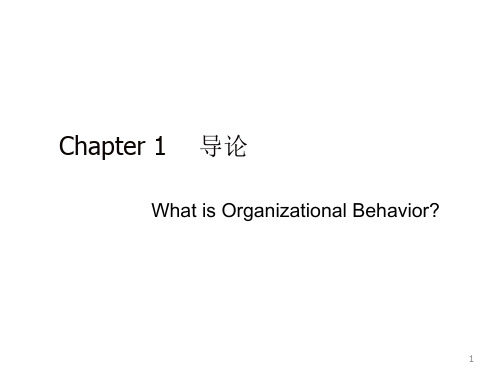
员工旳能力类型与水平 工作要求
类型不匹配或能力过低旳后果:
活动无法顺利进行——生产率下降 挫折和压力、酬劳降低——满意度下降
能力水平过高旳后果:
工作麻疲大意、高劳动力成本——生产率下降 待遇低、没有施展才干及成长机会——满意度下降
14
2.1.3 应用
1、尽量确保员工能力与工作之间旳匹配 匹配旳最佳方式是员工旳能力稍低于工作要求
53
价值观旳起源
文化差别 成长旳微观环境 个体自己
霍夫斯泰德构架
1. 权力距离 2. 个人主义vs.集体主义 3. 男性倾向vs.女性倾向 4. 不拟定性规避。 5. 长久导向vs.短期导向
54
4.3 人格、价值观与工作旳匹配:
约翰·霍兰德:人业互择理论
职业人格:
现实型 研究型 社会型 老式型 创业型 艺术型
专业技能组
年龄
非专业技能组
年龄
18
2.2.2 性别
1、性别与生产率旳关系:
不明显
2、缺勤:
女性更高
3、流动:
流动率无明显差别,流动原因有性别差别
4、工作满意度:
不明显
19
2.1.3 任职时间
1、生产率:正有关 2、缺勤:负有关 3、与流动:负有关 4、任职时间与工作满意度:正有关
20
2.3 学习
作坏事情?
25
Chapter 3 态度和工作满意度
3.1 态度 3.2 工作满意度
26
3.1 态度
个体对客观对象所持有旳带有评价意义旳认知、
情感和行为意向。
认知成份 情感成份 行为成份
27
3.1.1 态度旳一致性
态度三个成份旳一致 态度与行为旳一致 海德旳平衡理论(P—O—X模型)
组织行为学理论

组织行为学:研究组织中人的心理和行为表现及其规律,提高管理人员预测、引导和控制人的行为的能力,以实现组织既定目标的科学。
组织的涵义:组织是一群人数集合,为了完成共同的使命和目标,组织成员按照一定的方式相互合作结成有机整体,从而形成单独的个人力量简单加总所不能比拟的整体力量,通过专业分工和协调来实现目标。
组织和环境:任何组织的生存和发展都依赖于特定的客观物质基础和社会条件,存在于组织之外并对组织产生一定影响作用的外部事物和现象就构成通常所说的组织环境。
组织和管理:所谓管理,就是在特定的环境下,对组织拥有的资源进行有效的计划、组织、激励、领导和控制,以达到既定组织目标的过程。
管理工作是独立进行的、有别于作业工作又为作业工作提供服务的活动,是保证组织正常运行、发展以实现组织目标的手段。
组织行为学的目标:⏹预测。
无论是在组织内部还是在组织外部,预测他人行为是我们日常生活的一个基本要求。
⏹解释。
组织行为学是解释组织中所发生的事情。
⏹控制。
对组织中发生的行为进行控制。
⏹分析和行动(引导)。
依靠适当的分析,管理者才能有效地采取行动,控制有关行为,处理所出现的问题。
组织是人生价值实现的地方人的各种活动,包括经济活动、政治活动、社会活动、企业活动、生产活动、营销活动等等,都会以组织的形式出现。
人离开了组织,就如鱼离开了水;没有人的组织也不成其为组织。
⏹组织能满足人的心理需求。
⏹组织目标的实现靠组织成员的努力。
⏹组织为个人价值的实现提供了舞台。
⏹组织与个人的有机结合才能使双方互惠互利。
个性:称为人格,是指个体在对人对己以及环境事务的适应中所显示出的异于他人的稳定和持久的心理特征。
个性在很大程度上决定着一个人的行为,了解一个人的个性,不仅可以掌握其目前的行为,而且可以根据其个性,预见其未来的行为。
知觉:是直接作用于感觉器官的客观事物的整体属性或各个部分在人脑中的反映。
价值观:是一个人对周围事物的是非、善恶和重要性的评价,是个人对某种特定的行为方式或存在状态的一种持久信念。
- 1、下载文档前请自行甄别文档内容的完整性,平台不提供额外的编辑、内容补充、找答案等附加服务。
- 2、"仅部分预览"的文档,不可在线预览部分如存在完整性等问题,可反馈申请退款(可完整预览的文档不适用该条件!)。
- 3、如文档侵犯您的权益,请联系客服反馈,我们会尽快为您处理(人工客服工作时间:9:00-18:30)。
Idea Champions
Managers who actively and enthusiastically promote an idea, build support, overcome resistance, and ensure that innovation is implemented
Challenge Stress – may improve performance
Hindrance Stress – comes from obstacles to achieving goals – mostly negative
Copyright © 2010 Pearson Education, Inc. 16-16
Based on humanistic-democratic values:
Respect for People Trust and Support Power Equalization Confrontation
Participation
Copyright © 2010 Pearson Education, Inc. 16-10
Essentials of Organizational Behavior, 10/e
Stephen P. Robbins & Timothy A. Judge
Chapter 16
Organizational Change
Copyright © 2010 Pearson Education, Inc. 16-1
Have high self-confidence, persistence, energy, and acceptance of risk
Use inspiration and vision to gain commitment
Have decision-making discretion
After studying this chapter, you should be able to:
1. Identify forces that act as stimulants to change.
2. List the sources for resistance to change. 3. Compare the three main approaches to managing organizational change. 4. Describe the causes and consequences of work stress. 5. Describe characteristics of a learning organization. 6. Explain global differences in organizational change and stress.
Increase driving forces that direct behavior away from the status quo Decrease restraining forces that hinder movement from the existing equilibrium Combine the two above approaches
Using outside consultants
• Appreciative Inquiry
Discovering what the organization does right
Copyright © 2010 Pearson Education, Inc. 16-11
Creating a Culture for Change
Managers have no direct control on personal stress and there are ethical considerations about intruding into employees’ personal lives
Innovation: a new idea applied to initiating or improving a product, process, or service Sources:
Structural – verbose organic structures with slack resources and long-term managers Cultural – encourage experimentation, reward success and failure, and celebrate mistakes Human Resources – actively promote training and development, have high job security, use idea champions
16-8
Copyright © 2010 Pearson Education, Inc.
Kotter’s Eight-Step Plan
1. 2. 3. 4. Create urgency Form coalition Create new vision Communicate the vision 5. Empower others 6. Reward “wins” 7. Consolidate improvements
6.
7.
Selecting People who Accept Change
Coercion
16-6
Copyright © 2010 Pearson Education, Inc.
Approaches to Managing Organizational Change
• Lewin’s Three-Step Model of Change
Copyright © 2010 Pearson Education, Inc.
16-13
Contemporary Issues
• Technology in the Workplace • Work Stress • Creating Learning Organizations
Copyright © 2010 Pearson Education, Inc.
Overcoming Resistance to Change
1. 2. 3. 4. 5. Education and Communication Participation Building Support and Commitment Implementing Changes Fairly Cooptation
• Kotter’s Eight-Step Model of the Change Process • Organi10 Pearson Education, Inc.
16-7
Lewin’s Three-Step Model
Unfreezing can be achieved by:
Copyright © 2010 Pearson Education, Inc. 16-15
Work Stress
Dynamic condition in which an individual is confronted with an opportunity, constraint, or demand related to what is desired and for which the outcome is perceived to be both uncertain and important • Types:
Individual • • • • • Habit Security Economic Factors Fear of the Unknown Selective Information Processing • • • • • Organizational Structural Inertia Limited Focus of Change Group Inertia Threat to Expertise Threat to Established Power Relationships and Resource Allocations
Copyright © 2010 Pearson Education, Inc.
16-2
Forces that Stimulate Change
16-3
Sources of Resistance to Change
People tend to resist change, even in the face of evidence of its benefits.
Movement
Refreezing
Unfreezing
8. Reinforce the change
16-9
Copyright © 2010 Pearson Education, Inc.
Organizational Development
A collection of planned-change interventions that seek to improve organizational effectiveness and employee well-being
• Outside consultants can provide objective perspectives, but don’t have to live with the consequences of change
Copyright © 2010 Pearson Education, Inc. 16-5
